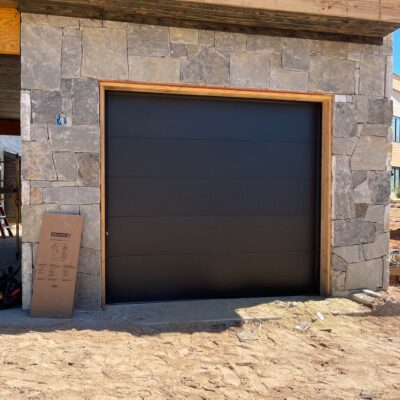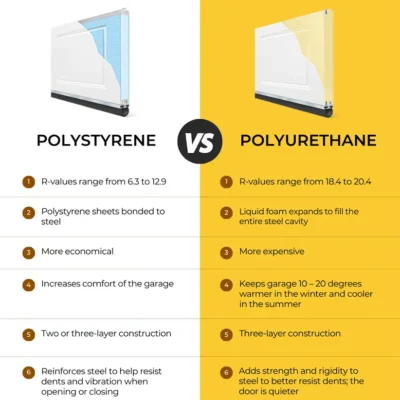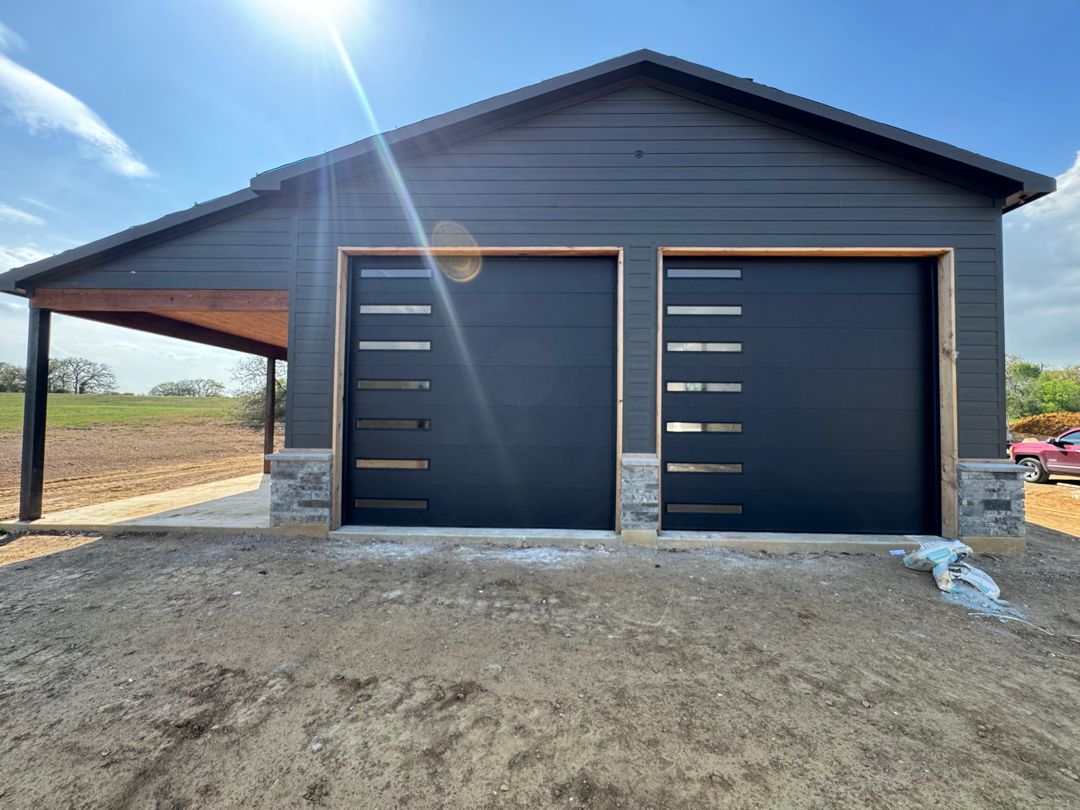At Doorvana, we offer a selection of flush or flat-panel garage doors from multiple vendors. While they all seem similar, there are a handful of differences that impact the finish, performance, and price. The goal of this article is to walk you through each consideration to help you find the exact door you’re looking for.
Our goal is to help homeowners and businesses select the right overhead garage doors for all types of projects. From homes and apartment complexes to auto dealerships and industrial warehouses, we strive to guide you to the right product for your taste, budget, and property. To that end, we spend a lot of time thinking through the small details that impact your initial purchase and ongoing maintenance. From time to time, we publish those thoughts and hope you find them helpful.
If you don’t quit and finish this article, you will be equipped with the information needed to confidently purchase a flush panel or flat panel garage door from any garage door dealer in the country.
Broadly speaking, these are the primary options to consider when purchasing a flush panel garage door:
- Texture
- Color
- Overall Thickness
- Steel Thickness
- Insulation
- Section Height
Understanding Texture Options
The texture of your garage door affects its appearance and how it complements the overall design of your property. Here are the main texture options available, ranked from most to least common.
- Stucco Embossed: This texture replicates the appearance of stucco, offering a subtle, textured finish. It’s excellent at hiding minor dents and scratches, making it a practical choice for families with active children or in areas where the door might face more wear and tear.
- Woodgrain Embossed: Despite being made of metal, these doors feature a wood-like texture. The grain pattern is stamped on the steel by the factory and does not overtly convey a wood garage door appearance. It’s just enough texture to hide dirt and minor scratches, without leaning into a farmhouse design.
- Smooth: For a sleek, contemporary look, smooth finish doors offer a clean and modern aesthetic. They work particularly well with modern and minimalist home designs, but may show scratches and dents more visibly. We recommend a factory finish on smooth, flat-panel garage doors versus a field-painted finish to ensure the best outcome.
- Matte: Matte finishes offer a non-reflective surface that adds sophistication to your home’s exterior. They’re less prone to showing fingerprints and smudges compared to glossier options, but will require complete section replacement if scratched because touch-up paint will stand out like a sore thumb.
When selecting a texture, consider the architectural style of your property and the other exterior elements. Your garage door should complement, not clash with, existing materials and textures.
Color Options for Your Garage Door

Your garage door color is an opportunity to let your style shine. Here’s what you need to know about color options for flush panel garage doors:
- Standard Manufacturer Colors: Most major garage door manufacturers offer a standard palette of approximately 8 to 10 colors. These typically range from classic whites and almond/tan shades to darker options, such as brown, gray, and black. These factory-applied finishes are designed to be durable and weather-resistant.
- Woodgrain Options: For homeowners who appreciate the warmth of wood without the maintenance requirements, many manufacturers offer woodgrain finishes that simulate the appearance of natural wood. Standard options include mahogany, walnut, and cherry.
- Custom Color Matching: Premium manufacturers, such as Amarr and Clopay, offer custom color-matching services. This allows you to coordinate your garage door perfectly with existing exterior elements of your home, such as windows or siding.
- Field Painting: If you purchase a white garage door, you have the flexibility to paint it any color you desire. However, it’s important to use appropriate exterior-grade paint that adheres well to the door material. Keep in mind that field-painted doors may require more maintenance than factory-finished options.
When selecting a color, consider the following factors:
- Your home’s existing color scheme and architectural style
- The colors of other exterior elements (roof, siding, trim)
- How the color will appear in different lighting conditions
- Regional and neighborhood aesthetic trends
Remember that darker colors absorb more heat, which can be a consideration in warmer climates. Additionally, some homeowners’ associations may have restrictions on exterior color choices; therefore, check the applicable rules before making your final decision.
Overall Thickness Considerations
The overall thickness of your flush panel garage door affects both its performance and installation requirements. There are two standard thickness options:
- 2″ Thickness: This is the standard thickness for most garage doors. The additional depth allows for better insulation properties, particularly when filled with polyurethane foam. These doors provide superior energy efficiency and noise reduction. We recommend this garage door thickness for new construction or when replacing a door without space constraints.
- 1-3/8″ Thickness: These thinner doors are specifically designed for retrofit applications where space is limited. They’re often required in older homes with a shallow drip ledge. Without this thinner option, you might need to cut concrete back up to an inch to allow the door to close and recess properly.
When deciding on door thickness, it’s important to have your opening professionally measured. The drip ledge consideration is often overlooked and can be a costly surprise.
Steel Thickness: Understanding Gauge
The gauge (ga) of steel used in your garage door directly impacts its durability and longevity. In steel measurements, remember that the lower the gauge number, the thicker the steel:
- 24 Gauge: This is the thickest standard option available for residential garage doors. Doors made with 24 gauge steel offer superior dent resistance and durability, making them ideal for homes in areas with extreme weather conditions or where the door might face potential impacts.
- 25-26 Gauge: These middle-range options provide a good balance between durability and cost. They’re suitable for most residential applications and offer reasonable resistance to denting.
- 27-28 Gauge: The thinnest options are more economical but offer less protection against dents and damage. They may be suitable for detached garages or in areas where the door is less likely to be impacted.
Garage door manufacturers commonly use a lighter gauge steel to line the interior of the garage door, since it is not seen from the outside. For example, the Amarr Northwoods NW3000 features a 24-gauge steel exterior and a 27-gauge steel interior.
Insulation: Comfort and Energy Efficiency

Insulation is crucial if your garage is attached to your home or if you use the space as more than just vehicle storage. Here are your options, starting from the lowest to highest performing insulation:
- Non-insulated: These basic doors provide no thermal barrier and are the most affordable option. They’re suitable for detached garages that don’t require climate control or in regions with mild climates. We always recommend some level of insulation.
- Polystyrene Insulation (R-value 6.64 to 12.9): Polystyrene insulation involves rigid polystyrene panels inserted between the door’s outer and inner layers. It provides moderate insulation and some noise reduction benefits. The insulation is covered with either vinyl or another layer of steel. Steel interiors offer a more “finished” look than vinyl and can be painted.
- Polyurethane Insulation with Steel Backing (R-value 13.35 to 20.4): This premium option features polyurethane foam injected between two steel panels. It provides superior insulation, significant noise reduction, and adds structural strength to the door. Polyurethane performs better because the liquid foam expands to fill the entire door cavity, where polystyrene is cut to size. Polyurethane insulation is ideal for those who care deeply about energy efficiency.
A well-insulated garage door can contribute to overall home energy efficiency, especially if your garage shares walls with living spaces.
Additional Considerations
1. Cost vs. Value
While it might be tempting to opt for the least expensive option, consider the long-term value. A higher-quality door may cost more upfront, but it could save money over time through energy savings, reduced maintenance, and a longer lifespan.
*As of 2025, replacing a garage door ranks among the top home improvement projects. Nationally, a $4,672 job cost will result in an increased home value of up to $12,507. CVV Report
2. Warranty
Warranty coverage increases as the door quality increases. For example, Amarr offers a lifetime warranty on its insulated garage doors with steel backing, but only a three-year warranty for non-insulated garage doors.
3. Design Compatibility
Ensure that your selected door complements your home’s architectural style. While flush panel doors are generally versatile, certain textures and colors work better with specific home designs.
4. Local Climate Considerations
If you live in an area with extreme temperatures, high winds, or corrosive environments (like coastal regions), choose materials and insulation levels that can withstand these conditions.
Making Your Final Decision
See, that wasn’t so bad, right? With several decades of home service experience, our team firmly believes that preparation and education upfront will save you time, money, and headaches down the road.
Whether you are buying flush panel garage doors for a new home or replacing an aging garage door, we hope you found this article helpful.
About the Author
Bobby Vickers, Founder of Doorvana Garage Doors
Bobby Vickers is the founder of Doorvana Garage Doors, a garage door manufacturer and Clopay, Amarr, CHI, and LiftMaster authorized dealer. His straightforward educational approach focuses on empowering clients by providing them with knowledge before they make essential home improvement purchases.


